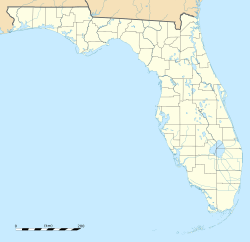San Juan de Aspalaga facts for kids
Quick facts for kids |
|
|
San Juan de Aspalaga
|
|
| Location | Jefferson County, Florida |
|---|---|
| Nearest city | Wacissa |
| NRHP reference No. | 73000581 |
| Added to NRHP | May 7, 1973 |
San Juan de Aspalaga (also known as Pine Tuft Site) was a Spanish mission built a long time ago in the early 1600s. It was located in the Florida Panhandle, close to the town of Wacissa, Florida today.
This mission was part of Spain's big plan to settle and control new lands in the Americas. One main goal was to teach Christianity to the Timucua and Apalachee Native American people.
The mission lasted for about 100 years. It was destroyed in the early 1700s. This might have happened because of attacks by Creek Indians and the English. The place where the mission once stood is now a special historic site. It was added to the U.S. National Register of Historic Places on May 7, 1973.
Contents
What Was San Juan de Aspalaga?
San Juan de Aspalaga was a type of religious settlement called a Franciscan mission. It was set up by Spanish priests, known as Franciscans. These missions were like small towns. They had churches, homes for the priests, and places for Native Americans to live and work.
The mission was important for Spain. It helped them claim land and spread their culture. It also aimed to convert Native Americans to the Christian faith. The site is sometimes called the Pine Tuft Site.
A Look at Spanish Missions
Spanish missions were very common in areas that Spain wanted to control. They were built across North and South America. These missions were not just churches. They were also centers for farming, education, and trade.
Why Were Missions Built?
The Spanish built missions for several reasons. First, they wanted to spread the Roman Catholic religion. Priests believed it was their duty to convert Native Americans. Second, missions helped Spain control new territories. They served as outposts in faraway lands. Third, missions taught Native Americans Spanish ways of life. This included farming methods, crafts, and the Spanish language.
Life at the Mission
Life at a Spanish mission was very structured. Native Americans living there would learn about Christianity. They also learned new skills like farming European crops. They might also learn how to raise livestock or make tools. The priests guided daily life, which included prayers and work.
The Native American People
The San Juan de Aspalaga mission was built in the lands of two main Native American groups. These were the Timucua and the Apalachee people. Both groups had lived in Florida for many centuries before the Spanish arrived.
The Timucua and Apalachee
The Timucua people lived in northern and central Florida. They were known for their large villages and farming skills. The Apalachee lived in the Florida Panhandle. They were also skilled farmers, especially of corn. Both groups had their own rich cultures and traditions. When the Spanish missions were built, these Native American groups faced many changes. Some chose to live at the missions, while others resisted.
The End of the Mission
San Juan de Aspalaga did not last forever. Like many other Spanish missions in Florida, it was eventually destroyed. This happened in the early 1700s.
What Happened?
During this time, there was a lot of conflict in the region. The English were expanding their colonies from the north. They often allied with Native American groups like the Creek Indians. These groups sometimes attacked Spanish missions. The attacks aimed to weaken Spanish control and capture people. It is believed that San Juan de Aspalaga was destroyed during one of these conflicts. This led to the end of the mission and its activities.
A Historic Site Today
Even though the mission was destroyed, its location remains important. The site of San Juan de Aspalaga is now protected. It is listed on the National Register of Historic Places. This means it is recognized for its historical value. It helps us remember the history of Spanish colonization and Native American life in Florida.



